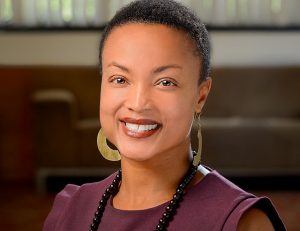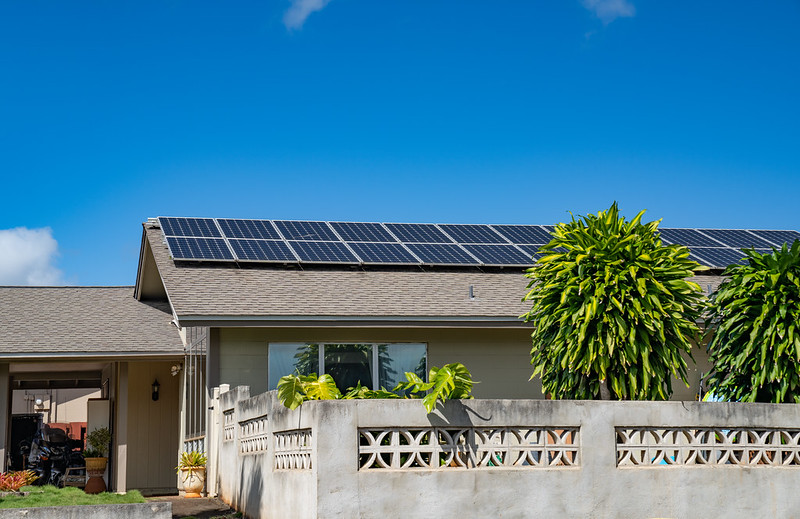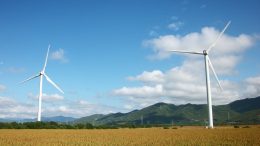When Shalanda Baker stopped in Oaxaca, Mexico in 2009 to brush up on her Spanish before heading to Colombia, she didn’t realize it would be a life-changing event. She’d just left her job at a corporate law firm with the hope of lending her expertise to coShalanda Bakermmunities fighting coal mines or other dirty energy projects in South America.
But in Oaxaca she met Indigenous community members fighting a different type of energy project: large-scale wind development.
“Their struggles echoed the stories of countless communities around the world affected by oil and gas development: dispossession, displacement, environmental harm, unfair contracts, racism and a litany of concerns about impact to culture and community,” she writes in her new book Revolutionary Power: An Activist’s Guide to the Energy Transition.
And she realized that in the pursuit of clean energy and climate solutions, we were on course to replicate many of the same injustices of the fossil fuel economy.
“I knew, in that moment, that this tension — between Indigenous rights and clean energy, between the rush to avert catastrophic climate change and social justice — would form the foundation of my work as an activist and scholar. It would also become my life’s work,” she writes.
Baker is currently a professor of law, public policy and urban affairs at Northeastern University and cofounder of the Initiative for Energy Justice, where she continues to work on making the clean energy transition more just.

The Revelator spoke with Baker about why we can’t solve our current climate crisis by following the same energy playbook and what it means to put justice concerns first.
“Energy justice” may be a new term for people. How do you define it?
I feel like it’s helpful to distinguish it from environmental justice as well as climate justice. They’re interrelated and, I think, inextricably intertwined.
Environmental justice is a product of the ’80s and ’90s, where people began recognizing the harms that Black and Brown communities disproportionately face due to industry, including the energy system. The movement was really aiming to remediate those harms through policy.
We had seen landmark environmental legislation passed in the 1970s which largely failed to address energy distributional concerns and largely left communities of color to fend for themselves through regular civil rights claims to sort out those burdens. And that actually didn’t work out.
So the environmental justice movement continues and on their shoulders is the climate justice movement, which very much recognizes that island communities and other communities in the Global South, as well as environmental justice communities including in the United States, will be the first and worst impacted by climate change.
So they’re really working to create policies that respond to that vulnerability.
But energy justice for me is the most hopeful aspect of this because it’s forward looking. To me, it’s about dreaming and saying, “What system can we create that not only remediates or helps to remediate some of that environmental harm, but can make us less vulnerable in the face of climate change?”
Rooftop solar, batteries, things that allow us to bounce back more quickly in the face of climate change — this hopeful terrain of energy policy that is reflective of energy justice principles is where I like to do my work.
You write in your book about how you first got into this work because you worried that we were going to make the same mistakes with clean energy that we made with fossil fuels. How have you seen this play out?
My first experience witnessing it was Oaxaca, Mexico where I met the Indigenous peoples fighting against “big wind.” And there was this moment where I thought, “Oh my gosh, we’re doing this the same way.” We’re relying on the same logic, the same structure, the same financing models. The same entities and corporations are basically just changing hats and changing names to be able to participate in the clean economy.
They’re still relying on extraction, exploitation and getting it done for the lowest cost, which often means massive projects that can really change the shape of communities.
That’s what was happening in Mexico in 2009. It’s still very much happening in Oaxaca, which is the windiest place in Mexico. It’s also happening in the Yucatan peninsula in a place that I went to in 2016 to do a Fulbright.
The second time I saw this was in Hawai‘i in 2014. At that time Hawai‘i was embarking on its own ambitious energy reform project. But it was approached as being about just a technical change — a switching of fuels to renewables. They were basically, again, replicating the inequality baked into the system.
In Hawai‘i folks pay the highest costs for electricity in the country, poverty rates are high and BIPOC [Black, Indigenous and people of color] communities live amidst fossil fuel generation. But BIPOC communities had no real say in shaping the energy future and were structurally excluded from it.
Moreover, communities were not viewed as stakeholders with an authentic economic interest in the projects that were slated for development. Because of this exclusion, I witnessed a lack of community participation in the overall development process, large-scale renewable energy projects going into BIPOC communities and rural communities without authentic community engagement, and a failure to think creatively about economic benefits (such as ownership) available to communities through clean energy development.
For me, the more tragic part was that the stakeholders and policymakers didn’t see the transition as an opportunity to create social change and to remediate structural inequality.
This approach mirrored Mexico’s wind energy development, and I saw, in Hawai‘i, a real missed opportunity to allow communities to design the new energy system in service of their vision and in service of the deeper principles of economic and social justice.
What response do you get when you talk about energy justice now?
If you had asked me that six months ago, I would have said that it’s very hard. No one’s listening, it’s terrible.
But since the COVID-19 pandemic, coupled with the murder of George Floyd, we have seen this sort of awakening, for lack of a better term, with respect to the multiple layers of oppression and inequality that certain communities face.
We know that communities of color are more likely to be environmental justice communities, breathing in toxic fumes. We know that they’re more likely to experience energy burden, paying more of their overall income to meet basic energy needs. And now we know that they’re more likely to die from a pandemic and that the likelihood of having the worst effects of COVID relates back to the energy system.
So now there’s an opening, there’s an opportunity. Since June there’s really been more of a willingness to learn about this — and not in just the typical places, but with policymakers, with folks from departments of energy around the country and attorneys general offices.
Are there examples of energy justice in action you’ve seen around the country?
I think it’s still too early to tell.
Rooftop solar was one way that people could have more control over their energy system and make some economic gains by creating their own energy and selling it back to the grid or offsetting their own use. But that opportunity and policy framework has largely left out a lot of Black and Brown folks.

The alternative was a model called community energy. Sometimes it’s about communities coming together or a church or another kind of institution in the community saying, “let’s create an energy project and we can all share in it.”
But unfortunately, I think we need more research to really know if it’s actually benefiting low-income folks and Black and Brown people.
So the jury is still out for me on how energy justice is manifesting. But I do think there are a couple of policy wins that we’ve seen.
One is in New York through the Climate Leadership and Community Protection Act, which was signed into law about a year ago and was very much a product of grassroots advocacy. A coalition called NY Renews made sure that that law included a carve-out for environmental justice communities [requiring] that 35% of climate investments have to go back to those communities.
We see similar things in California with Senate Bill 535, which is essentially a redistribution of the benefits of that state’s cap and trade policy to so-called “disadvantaged communities.”
So there are wins here and there, but we have to keep fighting.
What needs to change in terms to regulations or financing to help move that fight along?
There are two pieces of the financial story. One is the utility story. We have massive investor-owned entities that are essentially companies that are regulated to be able to provide power and get a reasonable return on any investments that they make in the infrastructure.
So as we move toward more distributed resources, there’s a pushback by these entities because they want to continue to own all of the assets and they want to continue to be able to get a return on any investments that they make in our electricity infrastructure.
But in an ideal world, we’ll see individuals and communities owning more of their energy assets, and then being able to share them across a grid that may be managed by an investor-owned or publicly owned utility.
And I think we need regulators to push utilities to behave in the way that we want them to behave.
We also need to think about how we organize our rate structure. Right now rates are generally regressive and they have higher impacts on the poorest folks.
The literature around energy burden says that we should be paying around 6% of our household income to meet energy needs. But some households are paying upwards of 40% or even 75%.
One problem is that low-income folks often live in housing that isn’t properly weatherized and energy is lost through holes in the walls or inefficient windows. Our standard programs for weatherization assistance are not reaching the places they need to be reaching.
I think the other part of this is how we get households access to rooftop solar. One study has shown a huge racial gap between those who have rooftop solar and those who don’t.
That gap is persistent even when you correct for home ownership, even when you correct for income, which indicates that there may be a racial dimension — maybe racism — with respect to why people just aren’t getting approached for rooftop solar or why they’re not able to put it on their homes.
We need to understand this problem more.
You write in your book about how the goal for many activists has been “climate first, justice later.” But you advocate for justice first. Why?
Bringing in the voices of folks who’ve been historically colonized and excluded for hundreds of years is just the morally right thing to do.
But I think more and more, we’re starting to understand that our fates are linked. And we cannot leave behind certain squads of the population in pursuit of our own gains. We have to make sure that they have a voice at the table and are able to bring life to their own vision of what the energy system should look like.
Or else we’ll get kicked by it at the end of the day. We’ll be hit by the realization that we’ve left out this entire segment of the population that can’t pay their electricity bills or that now has to move because of climate change. That will ultimately create substantial social costs down the road.
So for me, it’s about making a stronger society.
I really want ordinary folks — our aunts or uncles, our friends who are not in energy or environmental law and policy — to engage with these ideas and to see the ways in which energy is such an intimate part of our lives.
I want people to get curious and begin to organize around a just energy future. And to also maybe even get a little upset about the deep injustice that is embedded into not just the fossil fuel system — because that’s a story we know — but into this clean energy transition, where we are not only replicating but in some ways exacerbating inequality.
![]()


